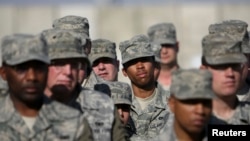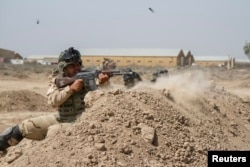As Islamic State (IS) fighters launched fresh attacks near northern Syrian border towns Thursday, U.S. policy experts and lawmakers say IS is growing in strength and number and that may warrant greater U.S. military involvement.
By the end of May, the Pentagon said it had conducted roughly 15,600 sorties in Iraq and Syria – at a cost of more than $9 million a day – and were killing more than 1,000 IS fighters every month.
But that may not be enough, analysts say.
“The military claims wide success, that they have destroyed a lot of equipment and killed a lot of people,” said Barry R. Posen, a political science professor at Massachusetts Institute of Technology and the director of MIT's Security Studies Program. “But it doesn’t look like that tactical success has generated any kind of a larger success.”
That leads some analysts to call for an escalated U.S. military presence – possibly including boots on the ground.
“We’ve got 250,000 dead in Syria,” said Hudson Institute’s Senior Fellow Michael Doran in a debate held this week at the Washington, D.C.-based Brookings Institution,
“We have half the population uprooted,” he said. “And the population will never ever go back to its homes, which means those refugee camps are going to be a hotbed of extremism. And also we have IS right at the center of the Arab world. We have a terrorist safe haven.”
Matters, he said, have only gone from bad to worse in the Middle East.
“President Obama…and some of his top officials have suggested that sooner or later, the Middle East is going to reach equilibrium,” Doran said “But clearly that is false.”
Democratic Senator Chris Murphy argued that there are better ways to protect U.S. interests in the region than putting troops in harm’s way.
“That presupposes that the only way to advance your interests is through military action,” he said. “If you have a true political and economic program on the ground…giving economic solutions to Sunni tribal leaders, then that gives them another reason to walk away from IS and to the central government.”
Degrading IS?
There is no way of knowing IS’s true size. Estimates range from 20,000 to 100,000 – even twice that, according to Britain’s Independent newspaper. It’s therefore hard to determine whether losing 1,000 fighters a month makes any sizeable difference in IS’s fighting power.
Consider the group’s recent gains, said Kori Schake, a research fellow at the Hoover Institution and former policy adviser to the 2008 McCain-Palin presidential campaign.
In just the past month, IS has taken the ancient city of Palmyra in Syria and the city of Ramadi in Iraq. The so-called “caliphate” now stretches from Raqqa in Syria to Fallujah – and IS fighters are inching toward the capital cities of Damascus and Baghdad.
“They are clearly already winning the war we are fighting,” said Schake, “and they are holding territory and administering governance in the areas they control.”
The Institute for the Study of War notes that in areas under its control, IS has established religious and educational institutions, courts and security services, water and electricity lines. It also attempts to run large industrial facilities, including dams and heating plants.
In short, it creates order in the chaotic environment of war. And these successes, says Schake, only increase its appeal among locals and would-be jihadists.
“Because it has a moral clarity that we are unwilling to bring to this fight,” she said. “Their recruitment is based on a clear statement of who they are, what they will fight for and what the world looks like when that’s over. And part of the reason that we are less effective, although we are much, much stronger, is that we are just not yet willing to do that, and I believe we should.”
Half steps, half measures
The second arm of the U.S. strategy against IS depends on building up local forces to be able to take on IS themselves.
Last month, the U.S. began training about 90 Syrian fighters and the Pentagon says it hopes to have a total of 3,000 fighters ready for battle by the end of the year. Out of 6,000 who have volunteered, only a third of them have so far been vetted.
Meanwhile, the Pentagon has sent 3,100 U.S. troops to Iraq and another 450 will shortly join them as part of ongoing efforts to recruit and train fighters.
The U.S. initially aimed to train 24,000 troops by fall 2015. But so far, the Pentagon says it has trained only 8,900 Iraqis, in part because the Iraq military has had a hard time convincing Sunnis to join up.
“You’re never going to build a force with half steps and half measures like this,” said retired Lt. General Michael Barbero, who was responsible for training, equipping and developing Iraqi security forces from 2009 to 2011.
“We need to acknowledge that we need a viable ground force, and the only one that is an option is the Iraqi security forces,” he said. “So first of all, let’s get serious about building and training and equipping Iraqi security forces, with the right numbers and the right effort.”
Barbero estimates it would take about 10,000 U.S. troops – not combat troops, he emphasizes – to get the Iraqi forces up to par.
“When you start setting up different bases, you need force protection. You need command and control. You need logistics. And then you need a good number of trainers and advisors to help them, enable the Iraqis to take the fight,” he said.
Barbero also calls for the U.S. to arm the Kurds directly, rather than channel arms and ammunition through Baghdad.
“They are loyal to us. They are our friends. They’ve asked for it. They need it. We should be doing everything we can for them,” Barbero said.
But Barry Posen fears the U.S. is headed into another open-ended conflict.
“There never was an Iraqi army,” Posen said. “What there was were Iraqi units inside a U.S. army,” he said. “And as long as they were in the US army, they were okay. They could be used for some things. They could be relied upon. But essentially, when you took the training wheels off the bicycle, they rode the bicycle into the ditch.”
The only way to bring the Iraqi military back up to snuff, Posen says, is to bring in thousands of U.S. troops.
“But then you’re on the slippery slope,” Posen said. “Every time you do one of these interventions, you create an expectation of success and you justify it on the basis of a narrative of desperate necessity.”
What if it doesn’t work, asks Posen, remembering the Gulf War.
“Are you going to be able to brush your hands together and say, ‘Well, we tried that, it didn’t work, time to go home’? Or, will we just send in more troops?”












